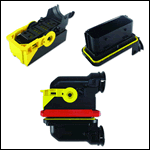The Promise of Reversible USB Type-C Connectors
The new reversible USB Type-C connectors will replace existing USB types.
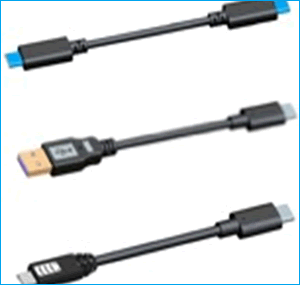 The first PCs and related accessories that incorporate the new USB Type-C connectors are now being released. Type-C connectors are covered by the recently updated Standard USB 3.1 (April 3, 2015) from the USB Implementers Forum (USB-IF) and will be used with both hosts and devices to replace the current multitudes of Type-A and Type-B connectors, adapters, and cables.
The first PCs and related accessories that incorporate the new USB Type-C connectors are now being released. Type-C connectors are covered by the recently updated Standard USB 3.1 (April 3, 2015) from the USB Implementers Forum (USB-IF) and will be used with both hosts and devices to replace the current multitudes of Type-A and Type-B connectors, adapters, and cables.
The USB-IF estimates that USB products are currently shipping at a rate of three billion USB products annually. USB operates at up to 5Gb/s and is found in more than 10 billion PCs, consumer electronics, and mobile devices. USB is the most successful interconnect in the history of personal computing and has migrated into consumer electronics (CE), mobile products, and even mil-aero applications.
As usage grew, the USB-IF continued to develop faster total-system performance that would include mechanically superior connectors. Drivers for the new connectors include reversible plug-in, higher-power handling, and miniaturization. Nicknamed “SuperSpeed,” the new standard includes multiple options for new and backward-compatible connectors. The new Type-C connectors have 24 contacts in a package size similar to the older USB2 micro Type-B connectors.
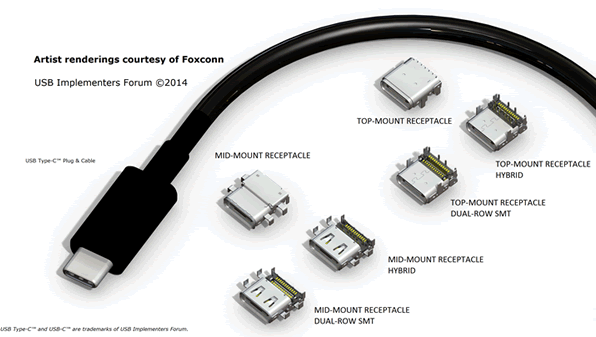
USB Type-C is termed “universal” as it is reversible (while the Type-A is unsymmetrical and polarized). The USB 3.1 standard is backward-compatible with USB 2.0 and USB 3.0. Going forward, new devices are designed to take advantage of its faster transfer mode of 10Gb/s. USB 3.1 specifications now also support increased power handling of 3.0A over the 5V power bus. Full-feature Type-C cable assemblies are termed “active” in the new standard and include a chip with an ID function. (The term “active” may be misleading; “active” is defined in the Type C spec as it involves signal processing. The eMarker itself is not considered active.) The chip permits both ends of the cables to identify their operational tasks to mating equipment. When properly marked and “electronically identified,” suitable cables may handle 5A and up to 100W of power for docking or charging applications.
While standard USB Type-A and Type-B connectors typically have four contacts and the micro and mini versions have five contacts, the new Type-C has 24 contacts. While signal content may be backwards-compatible, going forward requires new connectors and cables. Most users also will need cables that go from Type-C receptacles to existing Type-A and Type-B equipment. Fortunately, the USB specification for Type C connectors includes data for these combination cables.
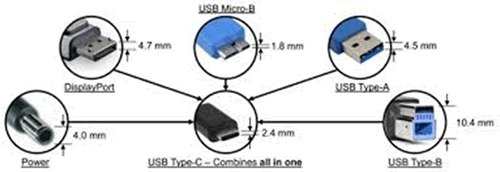
Contacts for USB Type-C connectors are different than those in prior USB assemblies. The 24 USB Type-C contacts are in two rows on 0.5mm spacing. Each row has four unique contacts used for GND (ground) and VBUS (power) with extended length for first-mate, last-break engagement. Receptacle contacts are single-beam design, with both rows tip-down toward the center for proper mating with the plug’s paddle-card configuration. Crosstalk between lines/contacts is minimized as both plugs and receptacles have ground planes central within the bodies (termed “Internal EMC Pads”) with multi-point terminations to ground. Type-C receptacle housings should engage the plug housing with a minimum of four grounding fingers. The receptacles have spring latches to help ensure positive mating to the plug.
Some Type-C connectors will need to interface with widely used mini USB (now decertified, but still standardized) and micro USB connectors. The USB 2.0 specification defined smaller device-side connectors for use with the then-next generation of handheld and mobile devices. At that time, the use of similar (but miniaturized) interconnects allowed manufacturers of devices, connectors, and cables to simplify new product acceptance by referencing their existing compliance tests and certifications from other USB products.
The micro USB connector was announced by the USB-IF in 2007. Micro USB plugs are similar in width to mini USB, but approximately half the thickness, which enables their use in thinner devices. The cellular phone carrier group Open Mobile Terminal Platform (OMTP) has endorsed micro USB as the standard connector for data and power on mobile devices. In addition, the International Telecommunication Union (ITU) has embraced micro USB as the universal charging solution for new mobile phones. Due to size and volume-related cost benefits, use of micro USB connectors will continue, but connecting them to other devices (for example, to transfer photographs to computers) may become a problem, prompting cables and adapters with micro USB plugs terminated to USB Type-C plugs.
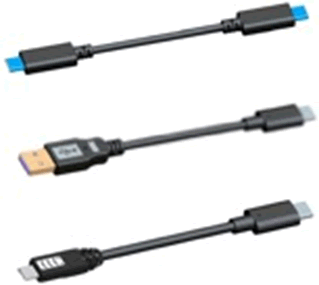
Comparison of cables with USB connector Type-A and -B versus the new USB Type-C (Photos compliments of ACON/Advanced-Connectek Inc.)
The USB 3.0 and 3.1 specifications do not specify wire cable size. However, they have established criteria for key parameters such as differential crosstalk, which measures the unwanted coupling between differential pairs. Both near-end crosstalk and far-end crosstalk for mated connector pairs are specified with recommended limits of -40dB for 100MHz to 5GHz; -36dB at 10GHz; and -30dB at 15GHz. End-to-end propagation delay is 20 nanoseconds maximum with 400 picoseconds rise time (20 – 80%) as measured by EIA 364-103. RF/microwave readers accustomed to 50 ohms should note that differential impedance for USB 3.1 is 75 to 105 ohms when measured per EIA 364-108.
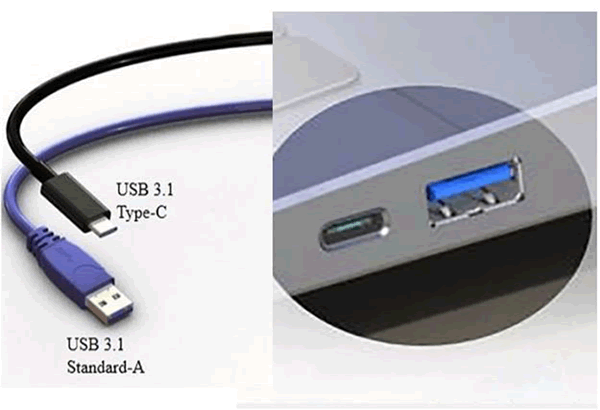
USB 3.1 Type-C connectors already are found in the latest computers. The first application was Nokia’s N1 tablet. Other start-up applications include Apple’s new 2015 MacAir 12 and Google’s second-generation Chromebook Pixel. Apple identifies this as an “industry-standard USB-C Port,” which for selected new MacBook Air models will replace all other chassis input/output connectors including USB (with USB 3.0 and 2.0 compatibility) and the Apple-unique MagSafe connectors (for charging), as well as the Thunderbolt 2 connectors (for connection to LCD projectors, etc.). Apple users are accustomed to unique connectors and cables, going back to the early Macintosh and Apple II computers that used special 19-pin D-subminiature connectors to interface with external drives.
Other device manufacturers that were involved with USB 3.1 and Type-C connector standardization include Dell, Hewlett-Packard, Agilent Technologies (now Keysight Technologies), Intel, Teledyne LeCroy, Lenovo, Microsoft, Nokia, and Samsung. Connectors, cables, and adapters with USB Type-C should become readily available as many international connector suppliers participated in creating this industry specification and now offer USB 3.1 connectors. This includes Advanced-Connectek Inc. (ACON), FCI, Foxconn (Hon Hai), Hirose Electric, JAE, JST Manufacturing, and TE Connectivity.
[hr]
- New Circular Connectors Add to Multi-Billion Dollar Market - January 9, 2024
- Counterfeit Components Ground Airlines - December 12, 2023
- Cables, Connectors, Waveguides, and Hybrid Products for up to THz at IMS 2023 - July 11, 2023



